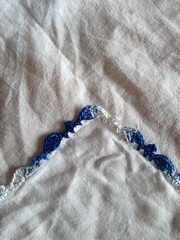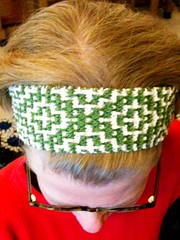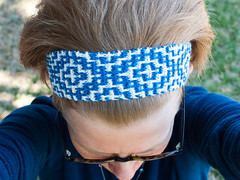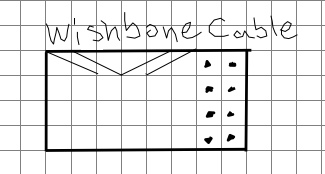Updated October 17 2008 with better edging instructions!


I had about 38 grams of a 50-gram skein of Knitpicks’ Shadow merino laceweight leftover from my sister’s Print o’ the Wave stole, and I wanted to whip up a bit of lace to enter in our fair this summer. So I planned out an easy little lace scarf. I knit the edging on the long sides as I went along, so I was able to use up almost all the yarn and then just save a little for the edging on the two short sides.

Yarn: any leftover laceweight, 30 grams or more (less is fine but will make a rather short scarf)
Needles: your favorite lace needles. I used Knitpicks Harmony circs size 2, but I am a notoriously loose knitter, and I think it would have looked better if I’d used bigger needles anyway. You’ll probably want size 3 to 5, or even larger if you knit very tightly. Larger needles = longer/wider scarf.
Finished Dimensions: Mine turned out to be about 9 1/2″ x 52″ after blocking. Yours will surely vary somewhat!
Ok, think of this scarf as being made of several columns. The right-side edging is the first column, then a 2-stitch always-purl garter column, then a fern-lace column worked over 16 stitches, then another 2-stitch column of garter, then another fern-lace column, then another garter column, then the left edging. If you want a wider scarf or a stole and you have plenty of yarn, you can work more fern lace columns separated by garter columns. If you want skinny, just work one repeat of the fern lace (just like the chart).
Wrong sides: always knit the wrong side of the edging, always purl the wrong side of the fern lace and garter columns. I’ll say this again later on so you don’t forget.
Start by casting on using your favorite provisional cast-on. I prefer this one.
You’ll need 4 st for the right edging, 2 for the first garter column, 16 for one fern repeat, 2 for the garter column between fern repeats, another 16 for the second fern repeat, 2 more for the last garter column, and then 4 for the left edging. Which makes, um, 46. Yes, cast on 46! Place ring markers between every column so there’s never any doubt what’s what and where you are. Seriously. I don’t usually have to do that, but I messed up a lot until I gave in and placed markers.
Now begin following the chart. Chart shows only odd-numbered right side rows (if I’d remembered to write the numbers in they’d be 1, 3, 5, 7, etc.) Go ahead and write them in :) For even-numbered, wrong-side rows, KNIT the edging stitches and PURL all the other stitches.

(D’OH. I forgot a symbol key. Circle = YO. Dot = purl. Right edging dec: ssk. Left edging dec: k2tog. Right side of fern lace dec: k3tog. Left side of fern lace dec: sl1, k2tog, psso) (Another note: the edging is an 8-row repeat. The fern lace is a 12-row repeat. The chart shows 24 rows so the two patterns work out even.)(Chart shows only odd-numbered, right-side rows)
Casting off for pointy edging:
When you complete the 7th row, you’ll have 8 edging stitches on each side. On the 8th (wrong-side) row, cast off the first 4 stitches so you only have 4 stitches remaining before the first marker. Work across. When you turn to begin the 9th row, immediately cast off 4 stitches (4 stitches remain before first marker) — then follow chart for row 9 (k1, yo, ssk, yo, k1).
Ok, so keep working until you’re nearly out of yarn. End after having cast off the edge stitches so there are 4 stitches remaining on each side next to the purl columns (you might have to fudge this a bit). I put my working stitches on a string after a while and worked the edging across the cast-on stitches using the other end of the yarn, and then I knew I really only needed a little bit left for the last short edging.
To work the short-end edgings:
If you’ve ever knit an edging onto a piece of lace, you know what to do. If you haven’t, well, I’ll do my best to explain :)
Hold the scarf right-side facing you, and cast-on edge up. Slide a needle through 6 cast-on loops from left to right – 4 loops for the edging and 2 loops for the garter column. The tip of the needle will be pointing toward the rest of the cast-on loops. Ok. Now, slide the other end of your circular needle through the rest of the loops from right to left.

Start working from the point between the needles, toward the left . You’ll be working the garter column and edging according to the left side of the chart. Always SLIP the first stitch of EVERY RIGHT SIDE row. So, for the first row: sl1, p1(place marker here to divide edging from garter column), k1, yo, k2tog, yo, k1. Turn, work wrong-side row: K5, slip marker, p1 — NOW ssk the last st together with the first stitch from the other needle. Drop the right-most loop of the ssk’d stitch but leave the left-most loop on the needle, and use it next time to help the corner lie flat.

Turn, work next RS row from chart: sl1, p1, slip marker, k2, yo, k2tog, yo, k1.
Turn, work next WS row: k6, slip marker, p1, ssk with the stitch you didn’t drop last time to help the corner lie flat. Drop the whole ssk’d stitch this time.
Next RS row: sl1, p1, slip marker, k3, yo, k2tog, yo, k1. Turn. WS row: k7, slip marker, p1, ssk (drop only right loop of ssk’d stitch again, and save left loop for the next ssk)
RS row: sl1, p1, slip marker, k4, yo, k2tog, yo, k1, turn.
WS row: this is the 8th row, the one where you cast off four stitches to create a point. CO 4, k4 (make sure you have only 4 loops left before marker), slip marker, p1, ssk with leftover loop of last ssk.


Keep working edging and purl column, decreasing away stitches from the original cast-on stitches on every wrong side row (don’t double up ssks anymore) until there are only 8 cast-on stitches left. (Better put a marker 8 stitches in from the other side so you remember that that’s the time to double up your ssks again (ask me how I know that you’ll forget otherwise… )
For the last repeat, double up the decreases again so the corner lies flat. That will eat up two of the last 8 stitches.
Then when you’re all done, weave the 6 remaining cast-on stitches together with the 6 working stitches. Voila!


Do the same thing with the live stitches at the other end of the scarf.
Gently wash and block your scarf. Enjoy!

UPDATE (July 8 2008): At our County Fair this year, my scarf won first prize and a special donated award — a $50 gift certificate to a local yarn store, Common Threads, in Encinitas.

Here’s Marlene‘s scarf:
















































